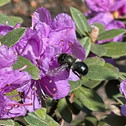KMS Native Plants is excited to be a mason bee rancher! Mason bees are small but very important early pollinators that rely on early-blooming plants like our native trees and shrubs. They are solitary bees in the wild but will live among others when ranched (as seen in pictures). They are called mason bees because they use mud to separate and protect the eggs in the hollow reed (or stem). The female eggs are laid first in the back of the reed and the male eggs are laid in the front. The mason bee may be observed close up as it is quite docile and shy. The male does not sting (this applies to all bees). The female has a sting, but she rarely uses it. Mason bees live a short life, emerging in late March/early April and dying by mid-June.
For all the information you need on the adorable mason bees, please go to the Blossom Meadow Farm website at https://blossommeadow.com/mason-bees/.
If you are interested in becoming a bee rancher too, please get in touch with Laura Klahre as soon as possible at LAURA@BLOSSOMMEADOW.COM (pickup date is the weekend of March 25th). Tell her KMS Native Plants sent you.
Photos (KMS Native Plants): Mason bee house with hollow reeds and chicken wire to keep the birds out, Mason bee visiting a PJM rhododendron (not native), Mason bee relaxing in the sun, last two are Mason bees at work
Trees:
Acer negundo (Boxelder)
Acer pensylvanicum (Snakebark Maple)
Acer rubrum (Red Maple)
Acer saccharinum (Silver Maple)
Acer saccharum (Sugar Maple)
Cercis canadensis (Eastern Redbud)
Prunus serotina (Wild Cherry)
Prunus virginiana (Chokecherry)
Quercus alba (White Oak)
Quercus coccinea (Scarlet Oak)
Quercus ilicifolia (Bear Oak)
Quercus macrocarpa (Bur Oak)
Quercus palustris (Pin Oak)
Quercus phellos (Willow Oak)
Quercus rubra (Red Oak)
Quercus velutina (Black Oak)
Salix discolor (Pussy Willow)
Salix pumila var. pumila (Prairie Willow)
Sassafras albidum (Sassafras)
Shrubs:
Amelanchier canadensis (Serviceberry)
Amelanchier laevis (Allegheny Serviceberry)
Arctostaphyllos uva ursi (Bearberry)
Aronia arbutifolia (Red Chokeberry)
Aronia melanocarpa (Black Chokeberry)
Cornus alternifolia (Pagoda Dogwood)
Cornus amomum (Silky Dogwood)
Cornus florida (Common Dogwood)
Cornus racemosa (Gray Dogwood)
Cornus stolonifera (Red Twig Dogwood) syn Cornus sericea
Ilex glabra (Inkberry)
Ilex verticillata (Winterberry)
Lindera benzoin (Spicebush)
Physocarpus opulifolius (Ninebark)
Prunus maritima (Beach Plum)
Rhododendron maximum (Rhododendron)
Rhododendron viscosum (Swamp Azalea)
Sambucus canadensis (Black Elderberry)
Vaccinium angustifolium (Lowbush Blueberry)
Vaccinium corymbosum (Highbush Blueberry)
Viburnum acerifolium (Mapleleaf Viburnum)
Viburnum dentatum (Arrowwood Viburnum)
Viburnum trilobum (American Cranberrybush)
Perennials:
Asclepias tuberosa (Butterfly Weed)
Callirhoe involucrata (Poppy Mallow)
Fragaria virginiana (Wild Strawberry)
Geranium maculatum (Wild Geranium)
Helianthus divaricatus (Woodland Sunflower)
Penstemon digitalis (Foxglove Beardtongue)
Penstemon hirsutus (Hairy Beardtongue)
Rudbeckia triloba (Brown-eyed Susan)
Viola labradorica (Labrador Violet)
Viola sororia (Common Violet)
Have fun!











Kommentare